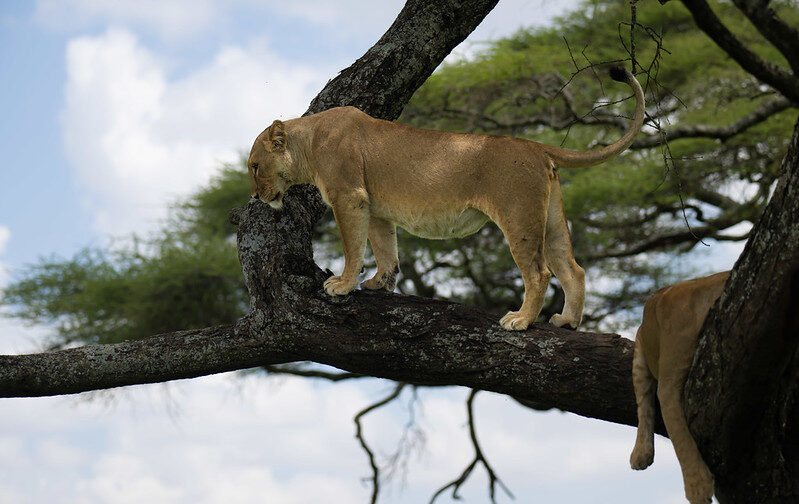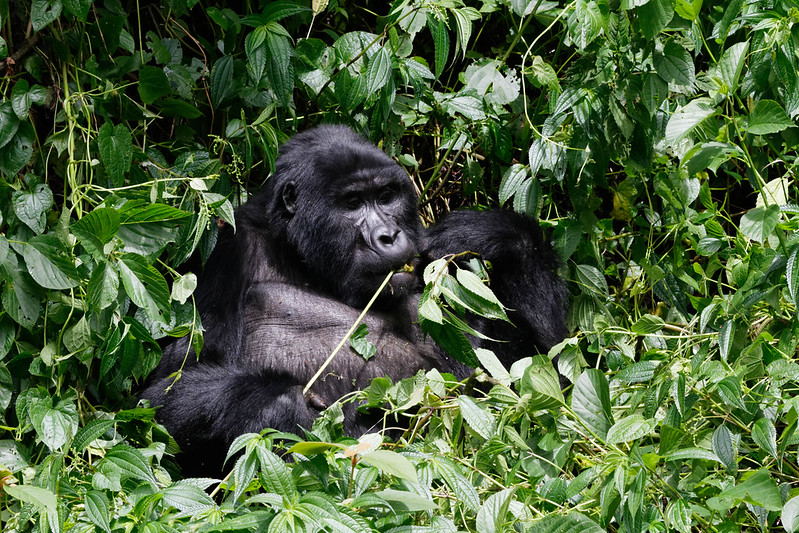The Tree-Climbing Lions of Ishasha Sector, Queen Elizabeth National Park.
Seeing lions lying elegantly in the Ishasha Sector’s treetops of Queen Elizabeth National Park is one of Uganda’s most amazing wildlife shows. Often referred to as the “tree-climbing lions, these large cats have established themselves and still captivate both researchers and tourists.
Ishasha is a special and interesting area for those who like animals as tree-climbing behavior in lions is unusual and has only been recorded in few locations worldwide. Examining their distinctive behavior, the causes of their tree-climbing tendencies, and the best methods to see this spectacle in Queen Elizabeth National Park, this page explores the world of the Ishasha lions.
Tree-Climbing Lions
Although lions are renowned for their agility as ground hunters, their sightings from trees are rather unusual. Lions are hefty creatures, hence climbing trees is often a talent left to smaller, more nimble cats like leopards. But in Ishasha, these large cats are often seen stretched out on the branches of sycamore fig and acacia trees, seemingly defying their typical ground-dwelling habits.
Though the precise causes of this behavior are yet unknown, various hypotheses propose why Ishasha’s lions have gone to the treetops.
Rising trees in Ishasha could enable the lions to escape the unrelenting attacks of ground-dwelling insects like as tsetse flies, which abound on the savannah. Resting among the trees also offers a cooler surroundings and lets one appreciate a breeze in the warmest sections of the day.
Lions in Ishasha could scale trees to have a better view from which to track prey or keep an eye on their surrounds. Higher above, they can keep a watch on their area for competing predators and see possible prey species like buffalo and antelopes.
Another idea holds that this habit may have evolved as a learned or hereditary feature handed down via Ishasha’s lion ancestors. This unusual behavior might have grown more rooted in the pride over time, characterizing Ishasha’s lions in that regard.
Comparing Other Tree-Climbing Lions
Fascinatingly, while sightings are less often, Tree-climbing lions also exist in Lake Manyara National Park in Tanzania. Among lions, this behavior is still an uncommon occurrence; Ishasha is among the few sites where it may be routinely seen.
Investigating the Ishasha Sector: Tree-Climbing Lions’ Home
Near the Democratic Republic of Congo border, in the southwest of Queen Elizabeth National Park, is the Ishasha Sector. Different from the rest of the park, this region has broad savannahs, spreading fig trees, and riverine forests that provide the lions the ideal place to ascend.
Ishasha’s Particularly Unique Scene
The Ishasha terrain differs most from the grassy plains and crater lakes in the northern parts of Queen Elizabeth National Park. Ishasha works in a setting comprising.
Big fig and acacia trees provide the lions the perfect power and framework to climb and rest on robust limbs. Particularly the sycamore figs have wide branches that can hold a lion’s weight, enabling them to stretch out and relax naturally.
wide Plains and Seasonal Rivers: The Ishasha plains provide wide vistas that facilitate the spotting of animals, especially the tree-climbing lions. Rivers like the Ishasha River flood up during the rainy season, drawing animals to drink and providing great lion hunting area.
Nature Beyond Lions
Although Ishasha’s tree-climbing lions get most attention, the area also supports a variety of other species. Ishasha’s visitors could run across.
Large herds of buffalo and elephants sweep the Ishasha plains, sometimes straying near the fig trees where lions find repose.
Antelopes and Other Predators, Topi and Uganda kob, two antelopes found in the region draw lions as prey.
Sometimes leopards and hyenas are seen, which accentuates Ishasha’s rich predator-preying dynamics.
Ishasha has great birdlife, ranging from African fish eagle to gray crowned crane to many vultures often seen in the vicinity.
Ideal Viewing Time for the Tree-Climbing Lions
Although Queen Elizabeth National Park is accessible all year round, various seasons provide greater opportunity to see the tree-climbing lions.
The dry season runs from June to September and from December to February.
Ishasha is best visited during the dry season when animals gather around water sources and sightings of them are more expected. Less vegetative cover makes it also more difficult to see lions sleeping in trees or traversing the wide plains.
March through May and October through November is the Rainy Season.
Although the rainy season delivers rich green scenery, muddy pathways may make travel difficult. Still, this time presents the benefit of less visitors, and the landscape is very vivid, which makes it perfect for pictures.
Advice for Seeing the Lions Tree-Climbing
Ishasha’s tree-climbing lions might be elusive at times, hence seeing them calls both some technique and patience. These suggestions help you to improve your experience.
Lions are more active in the colder periods of the day, hence early morning and late afternoon are the optimal times to start game drives. Particularly in warmer months, the lions are more inclined to climb trees for cover at noon.
Local guides in Queen Elizabeth National Park have great understanding of lion behaviors and favored areas in Ishasha. They can guide you to places where lions are often seen and know how to identify them even if they are well hidden in the forest.
Lions may rest on branches well above the ground, hence having binoculars and a camera with a strong zoom can let you to see and picture them more closer without upsetting them.
Ishasha Conservation Work
Like any protected wildlife habitat in Uganda, Queen Elizabeth National Park presents continuous conservation issues. Efforts at conservation seek to protect Ishasha’s unique habitat including the tree-climbing lions. Important features of these initiatives include in.
Conservation groups and Uganda Wildlife Authority (UWA) fight poaching in and around Ishasha. By safeguarding prey species such as antelopes, lions have a sustainable food supply, therefore maintaining the whole ecology.
Local communities around Ishasha are very important for conservation. Eco-tourism and income from tourism help people become active participants in preserving the park and its biodiversity by means of benefits.
Studies on Ishasha’s lions’ particular tree-climbing habit are still in progress by researchers and wildlife biologists. Knowing why this pride has evolved such an uncommon habit helps guide more general conservation plans and offers understanding of lion survival and adaptability.
Arranging Your Ishasha Sector Visit
A bigger safari itinerary in Queen Elizabeth National Park includes the Ishasha Sector, which may be visited with other famous sites as the Kazinga Channel and Kyambura Gorge. Here are some doable travel planning pointers.
Choices for Accommodation
From cheap to luxury hotels, there are various places to stay close to Ishasha. Among the well-liked options are.
Set along the banks of the Ntungwe River, Ishasha Wilderness Camp provides reasonably priced, rustic lodging near the activity.
Slightly farther from the park, Savannah Resort Hotel offers more reasonably priced lodging with simple Ishasha access.
Nestled in the wilderness just outside Ishasha, Enjojo Lodge is a mid-range choice noted for its lovely bandas and plenty of chances for watching local fauna.
Arriving at Ishasha
Accessible by road, the Ishasha Sector may be included in a safari circuit spanning Queen Elizabeth National Park. One may alternatively fly into Kihihi airfield and drive from there to Ishasha.
Among Uganda’s most distinctive wildlife attractions are the tree-climbing lions of Ishasha Sector. For those fortunate enough to view them in their treetop perches, their peculiar behavior has attracted guests from all across the globe and produced an unforgettable experience.
Combining this unusual encounter with Ishasha’s great biodiversity and the breathtaking scenery of Queen Elizabeth National Park, a trip to this isolated part of Uganda offers an experience full of surprise and discovery.



